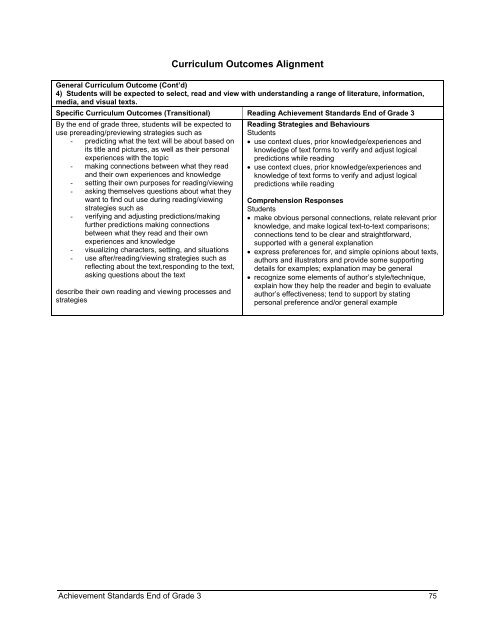Reading and Writing Achievement Standards Curriculum
Reading and Writing Achievement Standards Curriculum
Reading and Writing Achievement Standards Curriculum
You also want an ePaper? Increase the reach of your titles
YUMPU automatically turns print PDFs into web optimized ePapers that Google loves.
<strong>Curriculum</strong> Outcomes Alignment<br />
General <strong>Curriculum</strong> Outcome (Cont’d)<br />
4) Students will be expected to select, read <strong>and</strong> view with underst<strong>and</strong>ing a range of literature, information,<br />
media, <strong>and</strong> visual texts.<br />
Specific <strong>Curriculum</strong> Outcomes (Transitional) <strong>Reading</strong> <strong>Achievement</strong> St<strong>and</strong>ards End of Grade 3<br />
By the end of grade three, students will be expected to<br />
use prereading/previewing strategies such as<br />
- predicting what the text will be about based on<br />
its title <strong>and</strong> pictures, as well as their personal<br />
experiences with the topic<br />
- making connections between what they read<br />
<strong>and</strong> their own experiences <strong>and</strong> knowledge<br />
- setting their own purposes for reading/viewing<br />
- asking themselves questions about what they<br />
want to find out use during reading/viewing<br />
strategies such as<br />
- verifying <strong>and</strong> adjusting predictions/making<br />
further predictions making connections<br />
between what they read <strong>and</strong> their own<br />
experiences <strong>and</strong> knowledge<br />
- visualizing characters, setting, <strong>and</strong> situations<br />
- use after/reading/viewing strategies such as<br />
reflecting about the text,responding to the text,<br />
asking questions about the text<br />
describe their own reading <strong>and</strong> viewing processes <strong>and</strong><br />
strategies<br />
<strong>Reading</strong> Strategies <strong>and</strong> Behaviours<br />
Students<br />
• use context clues, prior knowledge/experiences <strong>and</strong><br />
knowledge of text forms to verify <strong>and</strong> adjust logical<br />
predictions while reading<br />
• use context clues, prior knowledge/experiences <strong>and</strong><br />
knowledge of text forms to verify <strong>and</strong> adjust logical<br />
predictions while reading<br />
Comprehension Responses<br />
Students<br />
• make obvious personal connections, relate relevant prior<br />
knowledge, <strong>and</strong> make logical text-to-text comparisons;<br />
connections tend to be clear <strong>and</strong> straightforward,<br />
supported with a general explanation<br />
• express preferences for, <strong>and</strong> simple opinions about texts,<br />
authors <strong>and</strong> illustrators <strong>and</strong> provide some supporting<br />
details for examples; explanation may be general<br />
• recognize some elements of author’s style/technique,<br />
explain how they help the reader <strong>and</strong> begin to evaluate<br />
author’s effectiveness; tend to support by stating<br />
personal preference <strong>and</strong>/or general example<br />
<strong>Achievement</strong> St<strong>and</strong>ards End of Grade 3 75
















